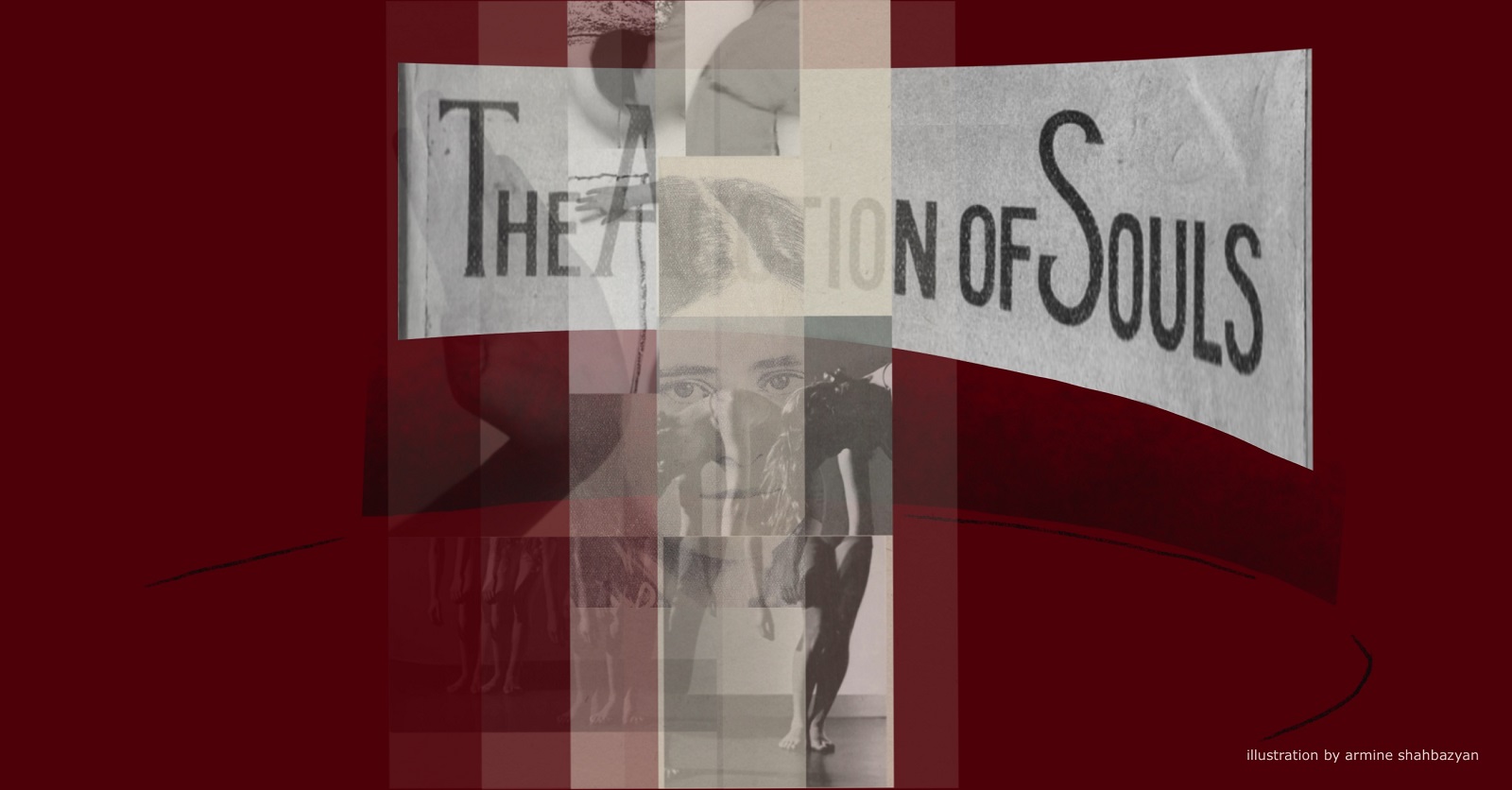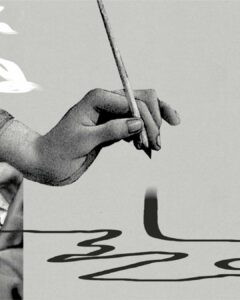
Listen to the article
Theater review: The Maxim Gorki Theater in Berlin, a world-renowned cross-cultural hub of contemporary performance art, recently showcased a 2015 piece by Arsinee Khanjian called Auction of Souls, about Aurora Mardiganian’s forgotten story.
Şermin Langhoff, the intendant of Berlin’s Maxim Gorki Theater, approached Khanjian to help develop a theater program featuring Armenian artists for the Genocide centennial. “The meeting was something like three hours, and then [Langhoff] said, ‘and what are you going to do…as an artist?’” said Khanjian, who had not prepared a pitch. “But at that moment, I realized that this was personally the most amazing thing being asked of me in Berlin; to be doing something in one of these amazing theater institutions,” she said.
How can we tell an important story that has been forgotten? In the context of the commemoration of the Armenian genocide centennial in 2015, the pressure was on for Armenian-Canadian actress and activist Arsinee Khanjian. She had to grapple with this question — and she had to do it fast.
In an interview with EVN Report, following the re-showing of her piece in Berlin for the 2024 Genocide Remembrance Day, Khanjian shared the significance of this project. Langhoff, a woman of Turkish descent who runs one of the most important spaces for sociopolitical discourse, was determined to tackle the Armenian genocide in a city with its own history of genocide and the largest Turkish population outside Istanbul. Khanjian knew her piece would focus on Aurora Mardiganian, and Langhoff understood the significance of this story to the German capital. Together, they began developing an idea that Khanjian had tucked up her sleeve. “There was one project that I had been considering for years. It was about Aurora Mardiganian and Auction of Souls, the actual film itself. This woman was an activist; she was really talking from the perspective of a lost part of history,” Khanjian said.
“Stories speak for themselves, but her story doesn’t speak for itself,” says Khanjian in the opening scenes and again towards the end of the performance. “Stories speak for themselves when they have a context, a background –– either explained or understood in our public consciousness…[Aurora’s] story doesn’t have that context unless someone provides that context, and this is what I’m trying to do,” explained Khanjian.
Aurora Mardiganian was a genocide survivor who was kidnapped and sold into the slave markets of Anatolia. She escaped to Tbilisi and eventually made her way to the U.S. where she was approached by screenwriter Harvey Gates to make a film about her experience. Her time in the spotlight was monumental, but also short-lived. She was promised fame and, more importantly for her, the power to make a difference. The film, released in 1919, visually interpreted Aurora’s testimony and was arguably the first genocide film in history and certainly the first told from a woman’s perspective. “This history was recorded beyond history books or memoirs in a very early project of filmmaking. The protagonist is the very survivor of the atrocities,” Khanjian added. Aurora Mardiganian was expected to become a household name who would revolutionize film, genocide, and gender studies.
Originally named Ravished Armenia, the film was later renamed to Auction of Souls and released as a shortened version after most of the footage was lost. It was projected to be a hit, a sensation, and very controversial.
Whether because of the film’s explicit sexual violence, or its shocking reenactments of her witnessed atrocities, some cinemas refused to show it, others saw it as a cultural phenomenon. Ultimately, the world saw her and the Armenian cause as a fad. And like all fads, both Aurora and her story were eventually forgotten. The film briefly generated high revenue but ultimately flopped, leaving Aurora with little to show for her labor. In her case, the effort involved reliving traumatic experiences during filming, which led her to suicidal thoughts and declining health. During filming, Aurora suffered injuries, had a panic attack when actors playing Turkish soldiers appeared on set, and one actress died of pneumonia after filming scenes outdoors in the nude.
“She [Aurora] wanted to say things in her own way and in her own words,” says Khanjian, but very shortly after the film’s release, the original cut of the film disappears. Aurora does not become a star as Hollywood had promised, though, according to Khanjian, it was never about her own reputation, “She does not become a part of the world where she would be the narrator of her own story through the wider context of the history of her nation. And then she was eventually forgotten, even by her own community, her own people,” Khanjian explained.
During the performance, the audience is taken on a journey of intertwined storylines that Khanjian has crafted, mirroring the true events of Aurora’s story. These narratives intricately braid the Armenian genocide, Aurora’s escape, her experience reliving her trauma on a film set where she didn’t speak English, watching the editor’s cuts, the film’s ultimate failure and Aurora’s own decline. Khanjian’s narrative-structures are complex, yet they remain sharp, seamlessly transitioning from one to another.
Khanjian takes on the role of an academic discussing Aurora’s story. She is intermittently interrupted by two actors, Taner Şahintürk and Sesede Terziyan, who perform behind a screen. On this screen, Auction of Souls is silently playing with a live projection of the actors superimposed over it. “The whole idea was that the images that you will see are the images that I see as I’m reading this horrifying text and the script and her testimony,” says Khanjian. It was important for her not to have anyone play Aurora but rather recreate the missing context so that Aurora’s story could finally speak for itself.
Khanjian’s language is direct. She does not sugarcoat or sensationalize Aurora’s suffering. At times, it seems as though she might begin to cry, but she never does, maybe her eyes are simply glossy from the bright lights of the projector.
Şahintürk and Terziyan alternate roles between victim and perpetrator, performing abstracted and contradicting scenes, ranging from pain and horror to laughter and playfulness which become almost indistinguishable. They pivot between symbolic acts, such as smashing pomegranates, a Turkish soldier laughing until he suffocates, and aggressive kissing (Aurora often used the term “kissing” to describe rape in her interviews.)
Khanjian opened up about her process of conceptualizing the performance when the challenge was to relay that which she would see in her mind’s eye when she herself used to read accounts of the genocide, “the only way was to take the impact of that, and then exaggerate it enough so that it becomes something inevitable to watch, you cannot dismiss it.”
During the performance, Khanjian sometimes yells “cut!” as if on a film set. The actors stop, and Khanjian begins writing on an overhead projector that beams onto the same screen behind which the actors stand. Khanjian begins her ‘lessons,’ writing key terms and definitions that either vaguely or explicitly describe what the two actors just performed: “Kissing: Touch or caress to signify romantic or sexual attraction,” for example. But like Aurora’s lost footage, Khanjian destroys the papers in a shredder on stage.
The screen serves as a portal to new narratives. Besides Khanjian’s writing and the live projection of the performances behind it, on the same screen, the audience also sees segments from a rare TV interview with Aurora, conducted shortly before her death and primarily in her native Western Armenian dialect. Khanjian described finding the footage as miraculous, given the challenges she faced while researching Aurora.
“There are two and a half hours of recording,” she said, “but towards the end, the interviewer says, ‘well, thank you very much.’…and [Aurora] says, ‘well, aren’t you going to ask me about Auction of Souls, this movie that I made?’ These historians didn’t even know who she was.” Khanjian was then able to find the missing second part of the interview, thanks to the Zorian Institute in Toronto. Clips from these interviews are intermittently screened throughout the performance and become an integral part of it.
Aurora’s resilience and survival, her dedication to activism, and her sense of humor in the interviews despite the horrors she describes are inspiring. By the end, Aurora becomes a canonical figure, a newfound icon. Khanjian has done justice to Aurora’s legacy, giving her the stage she deserved without exploitation, by filling in the missing gaps in her story left empty for decades, and eventually revealing their lessons. While some elements of the performance are open to interpretation, others, such as Khanjian’s monologues or Aurora’s interview, are direct, sober, and brutal.
“I hope that as we continue to unearth the 1915-18 genocide, that we can also somehow parallelly bring the history of Artsakh forth, and see what the patterns are,” she said.
Khanjian’s Auction of Souls is more than a modern take on a film. It represents its own form of storytelling that alternates between performance, historical accounts, archival footage, and an unconventional, contemporary and sociopolitical approach to theater that epitomizes Berlin’s Gorki even almost a decade after it premiered.
“Aurora Mardiganian, she only had her stories, her words…she tells exactly what happened the way she knew it happened or lived through it…I wanted to take on the responsibility of interpreting something that has happened to a lot of us.”
Also see
Tattoos and Silent Heroes: Women of the Armenian Genocide
Historian Elyse Semerdjian’s book, Remnants: Embodied Archives of the Armenian Genocide, presents an innovative approach to writing history. She blends disciplines and challenging narratives to reveal the understudied female experience of the Armenian genocide.
Read moreThe Experience of Alienation in Atom Egoyan’s Films
Film critic Alexander Melyan takes the reader on a journey of Atom Egoyan’s films that explore complex narratives including the immigrant experience, nostalgia, the search for home and longing for a lost homeland.
Read more5 Dreamers and a Horse
The directors of the documentary “5 Dreamers and a Horse” manage to think outside of genre limitations, and to blend the elements of magical realism and cinéma vérité to create a strange fairy tale that resembles the one in which we all live.
Read moreLove and [un]Love in “The Miracle Worker”
Nune Hakhverdyan reviews the Armenian production of “The Miracle Worker” staged by the Gyumri Drama Theater and Yerevan’s Hamazkayin Theater about the life of Helen Keller, and examines the relationship between parent and child.
Read moreThe Armenian Dream: Michael Goorjian’s Film About Charlie the Repatriate
Michael Goorjian’s feature film “Amerikatsi” succeeded in infusing a sentimental and “positivist” tone inherent to Hollywood cinema within an Armenian reality, writes film critic Sona Karapoghosyan.
Read more






